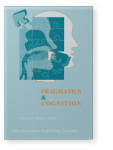Vol. 25:2 (2018) ► pp.337–362
From justification to modulation
Similarities and differences of after all and datte
The English discourse marker after all and the Japanese discourse marker datte have been commonly claimed to give a reason or justification to the preceding utterance, and therefore, these two expressions are regarded as the equivalent translation counterparts to each other. This paper first attempts to propose that such an equated account is motivated by these two discourse markers constructing a similar inferential schema involved in the interpretation of the utterance including them. In fact, datte and after all make manifest similar polyfunctions according to the syntactic position although they encode different lexical information. This is because these two discourse markers are indicators that contribute to the inferential phase of communication by various degrees of modulation of a cognitive gap between two different assumptions. Another aim of this paper is to differentiate a procedural constraint these two indicators encode on the interpretation of the utterance.
Article outline
- 1.Introduction
- 2.Multifunctionality and syntactic positions
- 2.1
After all
- 2.1.1Clause-final use
- 2.1.2Clause-medial use
- 2.1.3Clause-initial use
- 2.2
Datte
- 2.2.1Clause-final use
- 2.2.2Clause-medial use
- 2.2.3Clause-initial use
- 2.1
After all
- 3.Common inferential schema
- 4.Procedural constraints of after all and
datte
- 4.1Constraints on implicatures and constraints on higher-level explicatures
- 4.2Utterance-initial use of datte
- 5.Conclusion
- Acknowledgements
- Notes
- Abbreviations
-
References -
Data references
